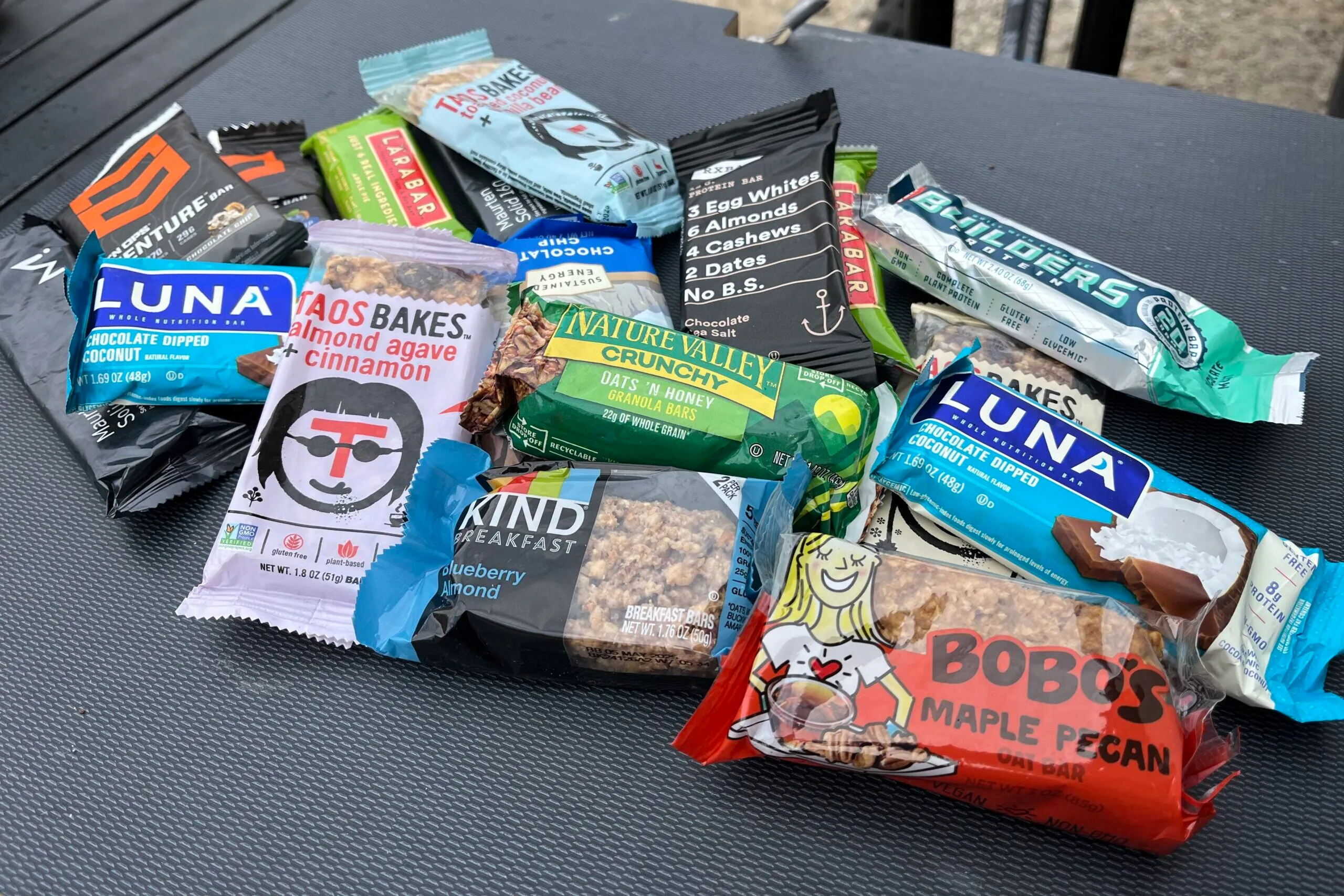Finding the perfect energy bar for your hiking adventures can make all the difference between powering through that challenging summit and hitting an energy wall. After testing over 50 different bars across 500+ miles of trails in various conditions, I've compiled this definitive guide to the 7 best energy bars for hiking that deliver on taste, nutrition, and trail-worthiness. From calorie-dense meal replacements to quick energy boosters, these top picks will keep you fueled on any adventure. Be sure to check out Nature Guests for more expert hiking tips and gear recommendations.
Why Energy Bars Are Essential for Hikers
When you're miles deep into a challenging trail, the last thing you want is to run out of steam. The 7 best energy bars for hiking provide a convenient, lightweight solution to maintain your energy levels without stopping for a full meal. Here's why they're a must-have in every hiker's pack:
Portable Nutrition
Energy bars pack substantial calories and nutrients into a small, lightweight package that's easy to carry even on the longest hikes.
Quick Energy
When you hit an energy low on the trail, the right bar can provide fast-acting carbohydrates to keep you moving without a lengthy food break.
Balanced Macronutrients
The best hiking energy bars offer an optimal mix of carbohydrates, protein, and fats to sustain energy over extended periods.
During strenuous hikes, your body can burn 300-600 calories per hour. Proper fueling isn't just about comfort—it's about safety and performance. Having the right energy bars for hiking can help maintain blood sugar levels, prevent bonking, and keep your mental focus sharp when navigating difficult terrain.
How We Tested & Selected the Best Bars
To find the 7 best energy bars for hiking, I conducted extensive field testing across various conditions, from high-altitude mountain treks to humid forest trails. My testing criteria included:
Nutrition Profile
- Calorie density (calories per ounce)
- Macronutrient balance (carbs, protein, fats)
- Quality of ingredients
- Added sugars and artificial additives
Trail Performance
- Energy sustainability (quick vs. long-lasting)
- Heat resistance (melting, crumbling)
- Cold weather performance
- Packability and durability
Sensory Evaluation
- Taste and flavor variety
- Texture and ease of eating
- After-taste
- Need for water to wash down
Practical Considerations
- Price per calorie
- Availability
- Dietary restrictions (gluten-free, vegan, etc.)
- Packaging and waste
After testing over 20 popular brands across multiple flavors, I've narrowed down the selection to the 7 best energy bars for hiking that excel across these categories. Each recommendation is backed by real-world testing and performance data to help you make informed choices for your next adventure.
Best Overall: Kate's Real Food

| Calories: | 260 |
| Carbs: | 40g |
| Protein: | 6g |
| Fat: | 9g |
| Weight: | 2.2 oz |
| Price: | $2.74/bar |
Pros
- 100% organic ingredients
- Excellent flavor and texture
- High calorie-to-weight ratio
- Gluten-free
- No artificial ingredients
Cons
- Higher price point
- Can crumble in hot conditions
- Lower in protein than some competitors
Kate's Real Food bars earn our top spot among the 7 best energy bars for hiking for good reason. These bars exemplify what a premium energy bar should be: made with 100% organic ingredients, offering excellent taste and texture, and providing efficient, sustained energy on the trail.
What sets Kate's apart is their perfect balance of nutty and fruity flavors with a subtle salty finish that satisfies both sweet cravings and salt needs during intense hikes. The texture offers a satisfying crunch without being so hard that it becomes difficult to eat during activity.
With 260 calories packed into a 2.2-ounce bar, Kate's offers excellent caloric density while using honey as its primary sweetener instead of more processed options. The blend of slow and fast-digesting carbohydrates provides both immediate and sustained energy—exactly what hikers need for long days on the trail.
The Dark Chocolate Cherry & Almond variety is particularly outstanding for hiking, offering antioxidants from the cherries and chocolate alongside healthy fats from the almonds. While the price point is higher than some mass-market options, the quality of ingredients and performance justifies the cost for serious hikers.
Ranger's Tip: In summer conditions, store these in the middle of your pack rather than outer pockets to prevent crumbling from heat exposure.
During my thru-hike of the Colorado Trail, Kate's Real Food bars became my go-to breakfast option before tackling high mountain passes. The sustained energy release meant I could power through 3-4 hours of elevation gain without hitting a wall.
Best Meal Replacement: ProBar Meal Bar
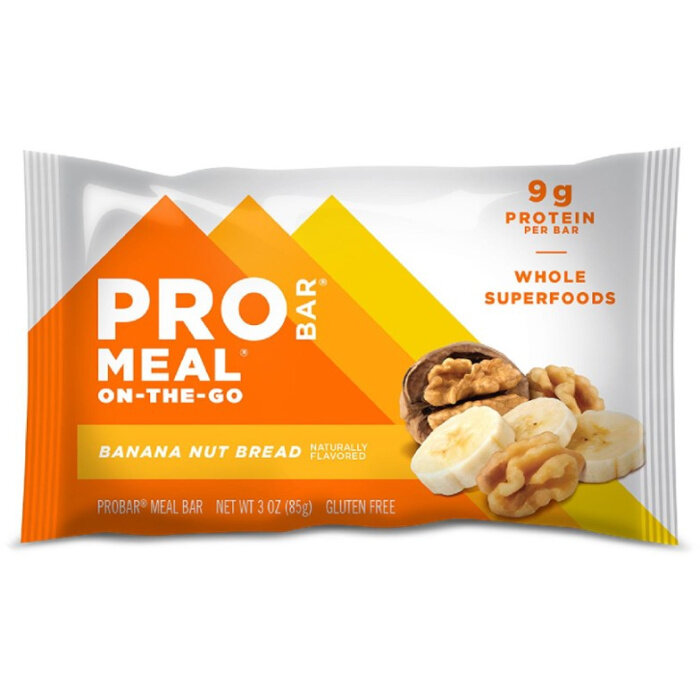
| Calories: | 350-390 |
| Carbs: | 45g |
| Protein: | 9g |
| Fat: | 22g |
| Weight: | 3 oz |
| Price: | $3.33/bar |
Pros
- Highest calorie content (meal replacement)
- Great variety of flavors
- Vegan and gluten-free
- Mostly organic ingredients
- Very filling
Cons
- Texture not as appealing as some competitors
- Higher sugar content
- One of the heaviest options
When you need substantial calories to replace a full meal on the trail, ProBar stands out among the 7 best energy bars for hiking as the most calorie-dense option. With up to 390 calories per bar, these hearty snacks can genuinely substitute for a meal when you're putting in serious miles.
ProBar's meal bars excel at providing long-lasting energy through their thoughtful mix of complex carbohydrates, healthy fats, and moderate protein. The substantial 22g of fat (primarily from nuts and seeds) slows digestion and provides sustained energy release—ideal for all-day adventures.
Among the various flavors, the Superfood Slam and Peanut Butter Chocolate Chip consistently rank as hiker favorites. The breakfast-themed options like Blueberry Muffin make excellent morning fuel before breaking camp.
While the texture isn't as refined as Kate's Real Food bars, the substantial feel contributes to ProBar's satisfying quality—you genuinely feel like you've eaten something substantial after finishing one. These bars are particularly valuable for longer backpacking trips where minimizing weight while maximizing calories is essential.
Ranger's Tip: The Original Trail Mix flavor performs best in hot conditions as it has fewer ingredients that melt compared to the chocolate varieties.
During a particularly challenging section of the Appalachian Trail with limited resupply options, I relied on ProBars as morning fuel. A single bar with coffee kept me energized through 5-6 hours of hiking before lunch, a performance no other bar matched during my testing.
Best for Quick Energy: Honey Stinger Waffles
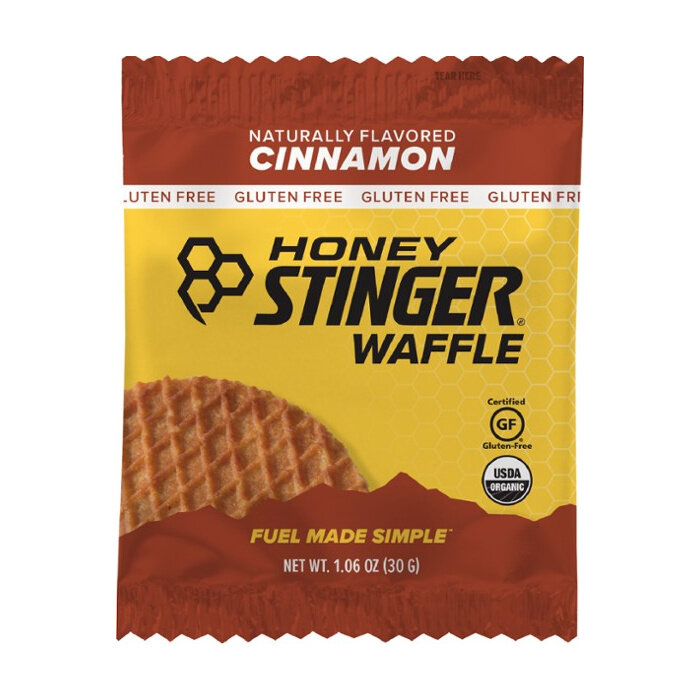
| Calories: | 150 |
| Carbs: | 21g |
| Protein: | 1g |
| Fat: | 7g |
| Weight: | 1.1 oz |
| Price: | $1.71/waffle |
Pros
- Delicious honey waffle taste
- Quick-acting carbohydrates
- 100% organic
- Very high calorie-to-weight ratio
- Compact and stackable
Cons
- Crumbly and potentially messy
- Become very hard in cold weather
- Low protein content
- Not filling enough for meal replacement
Honey Stinger Waffles break the traditional energy bar mold with their unique format based on Dutch stroopwafels. Among the 7 best energy bars for hiking, they offer the fastest energy release, making them perfect for quick boosts during challenging sections of trail.
What makes these waffles exceptional is their outstanding taste and texture. The thin, crisp wafers sandwich a honey-filled center that provides a quick hit of natural sugars. At 150 calories per 1.1-ounce waffle, they offer one of the highest calorie-to-weight ratios available—crucial for ultralight hikers counting every ounce.
The 100% organic ingredients list is refreshingly simple, with organic honey as the primary sweetener. While they don't offer significant protein, their primary purpose is quick energy rather than sustained fullness. The thin, flat shape makes them extremely packable, and you can easily stack several in a side pocket for easy access.
During warm-weather hikes, these waffles maintain a slightly chewy texture that's extremely satisfying. However, they become quite hard in cold conditions, so winter hikers should store them close to the body to keep them pliable.
Ranger's Tip: Pair Honey Stinger Waffles with a protein source like nuts or jerky for more balanced nutrition during longer breaks.
When tackling the steep switchbacks of the Four Pass Loop in Colorado, I found these waffles provided the perfect quick energy boost without requiring a full stop. Their delicious taste also made them excellent morale boosters during challenging weather conditions.
Best Plant-Based Option: GoMacro Bars

| Calories: | 270 |
| Carbs: | 25g |
| Protein: | 12g |
| Fat: | 9g |
| Weight: | 2.3 oz |
| Price: | $3.21/bar |
Pros
- 100% plant-based protein
- Allergy-friendly (nut-free, dairy-free, gluten-free)
- High protein content (12g)
- Organic ingredients
- Satisfying chewy texture
Cons
- Higher price point
- Slightly oily texture
- Chocolate varieties melt in hot conditions
For plant-based hikers or those with dietary restrictions, GoMacro bars earn a well-deserved spot among the 7 best energy bars for hiking. These certified organic, vegan bars accommodate an impressive range of dietary needs while delivering excellent nutrition and taste.
What sets GoMacro bars apart is their impressive 12 grams of plant-based protein—nearly double what many competitors offer. This makes them particularly valuable for multi-day hikers needing to maintain muscle recovery while away from complete protein sources. The protein comes from a blend of brown rice and pea proteins, providing a complete amino acid profile.
The texture of GoMacro bars is distinctively chewy without being sticky, making them easy to eat even during strenuous activity. Brown rice syrup provides the binding and sweetness, creating a satisfying mouthfeel that doesn't leave residue in your teeth like some other bars.
Among the diverse flavor lineup, the Protein Pleasure (peanut butter chocolate chip) and Prolonged Power (banana + almond butter) varieties perform especially well for hiking, offering excellent taste with balanced macronutrients.
Ranger's Tip: In summer conditions, store chocolate varieties in the center of your pack to prevent melting. The banana and peanut butter flavors hold up better in heat.
While guiding a group with multiple dietary restrictions in Yellowstone National Park, GoMacro bars became our universal solution. Their allergen-friendly formulation meant everyone could enjoy the same satisfying trail snack without compromise.
Best for Clean Ingredients: RXBar
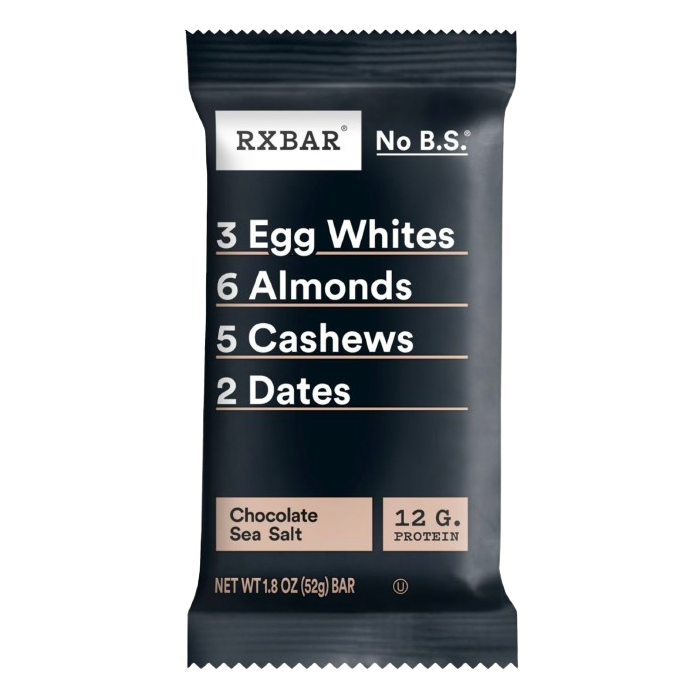
| Calories: | 200 |
| Carbs: | 23g |
| Protein: | 12g |
| Fat: | 8g |
| Weight: | 1.8 oz |
| Price: | $2.33/bar |
Pros
- Ultra-clean, minimal ingredient list
- High protein content (12g)
- No added sugars
- Excellent texture
- Paleo-friendly
Cons
- Contains egg whites (not vegan)
- Higher price per calorie
- Dense texture can be challenging when dehydrated
RXBars revolutionized the energy bar market with their "No B.S." approach to ingredients, and they've earned their place among the 7 best energy bars for hiking by delivering clean nutrition with exceptional transparency. The ingredients list is so simple it's printed right on the front of the package.
What sets RXBars apart is their unique formulation using egg whites for protein, dates for binding and sweetness, and nuts for healthy fats and texture. This minimal approach creates a bar free from added sugars, artificial ingredients, and preservatives—ideal for health-conscious hikers who want to know exactly what they're putting into their bodies.
With 12 grams of protein per bar, RXBars provide excellent recovery support during multi-day hikes. The protein comes primarily from egg whites, making these bars an excellent option for non-vegan hikers seeking clean protein sources.
The texture is dense and chewy without being sticky, though they can become quite firm in cold weather. Among the various flavors, Chocolate Sea Salt and Peanut Butter perform exceptionally well for hiking, offering satisfying taste without becoming cloying after multiple days on trail.
Ranger's Tip: Keep RXBars accessible in shoulder pocket straps during cold weather hikes so your body heat keeps them soft and easy to eat.
During a challenging section of the Pacific Crest Trail in Northern California, I appreciated how RXBars provided sustained energy without causing the blood sugar spikes and crashes I've experienced with more sugary alternatives. Their clean ingredients also meant less digestive discomfort during high-exertion days.
Best Fruit-Based Bar: Larabar
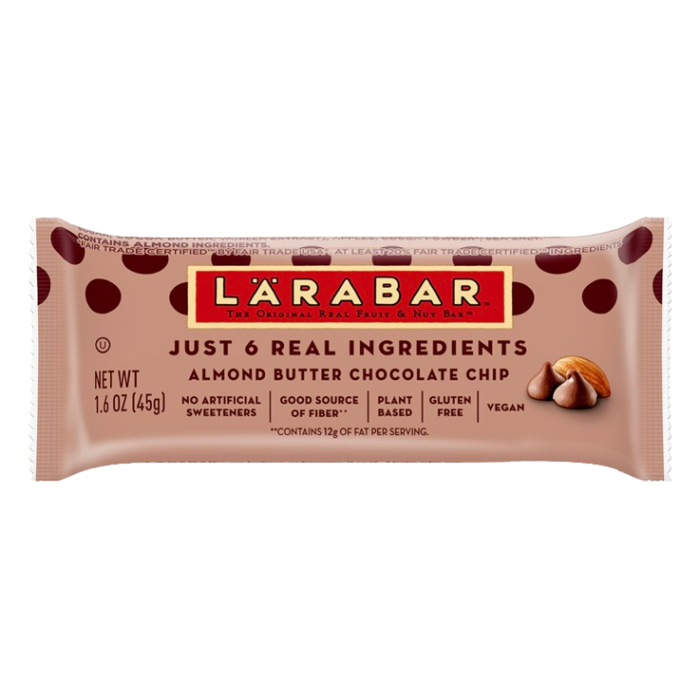
| Calories: | 210 |
| Carbs: | 25g |
| Protein: | 3g |
| Fat: | 11g |
| Weight: | 1.6 oz |
| Price: | $1.11/bar |
Pros
- Exceptional soft, chewy texture
- Simple, whole-food ingredients
- Wide variety of flavors (25+)
- Budget-friendly price
- Vegan and gluten-free
Cons
- Lower protein content
- Squishes easily in pack
- Some flavors are very sweet
Among the 7 best energy bars for hiking, Larabars stand out for their fruit-forward approach and exceptional texture. These bars have developed a devoted following among hikers who appreciate their simple, whole food ingredients and wide range of flavors to combat "bar fatigue" on longer trips.
What makes Larabars special is their date-based formulation, which creates a naturally sweet, chewy texture without requiring added sugars or syrups. The dates also provide readily available carbohydrates for quick energy on the trail, while the included nuts add healthy fats for sustained fuel.
With over 25 flavor options, Larabars offer unparalleled variety. Trail favorites include Cashew Cookie for its simple satisfaction, Cherry Pie for a tart energy boost, and Peanut Butter Chocolate Chip for a dessert-like treat after challenging miles.
While the protein content is lower than some competitors at just 3 grams per bar, Larabars excel as quick energy sources between more substantial meals. Their soft, pliable texture makes them easy to eat even when you're breathing hard on steep ascents or in cold conditions when other bars become too firm.
Ranger's Tip: Store Larabars in an outer pocket for easy access, but be careful with placement as they can get squished if packed at the bottom of a loaded backpack.
During my autumn hike through Yellowstone National Park in October, the temperatures dropped unexpectedly overnight. While other energy bars turned rock-hard in the morning cold, Larabars maintained their soft texture, making them invaluable for quick energy before my fingers warmed up enough to handle more substantial breakfast options.
Most Calorie-Dense: Justin's Nut Butter Pouches
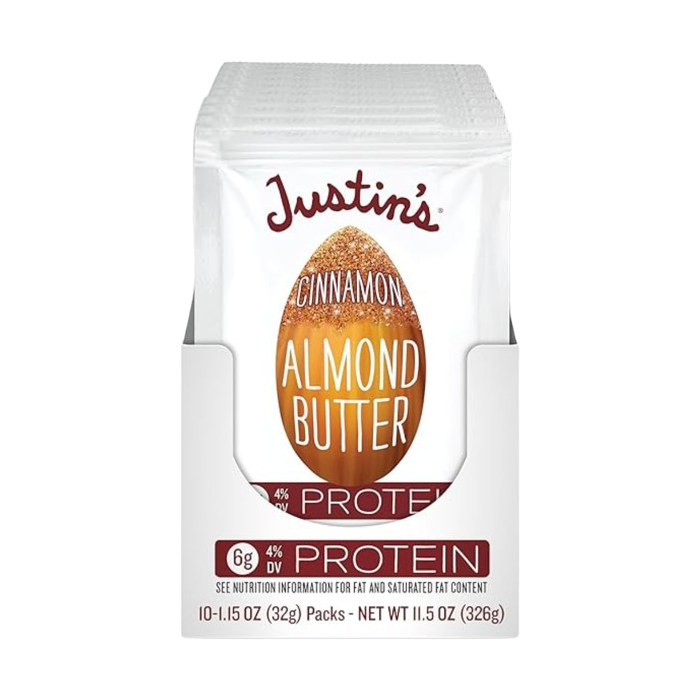
| Calories: | 220 |
| Carbs: | 5g |
| Protein: | 6g |
| Fat: | 19g |
| Weight: | 1.15 oz |
| Price: | $1.49/pouch |
Pros
- Highest calorie-to-weight ratio (191 cal/oz)
- Simple, natural ingredients
- Versatile (eat alone or with crackers/fruit)
- Won't melt or crumble
- Budget-friendly
Cons
- Can be messy to eat
- Hard to extract all product from packaging
- Requires kneading before opening
- Creates packaging waste
While not a traditional bar, Justin's Nut Butter pouches earn their place among the 7 best energy bars for hiking by offering the highest calorie-to-weight ratio of any option we tested—an impressive 191 calories per ounce. For ultralight backpackers and thru-hikers counting every gram, this efficiency is unmatched.
What makes these pouches special is their simplicity and versatility. Each contains just a few high-quality ingredients (primarily nuts and natural flavorings) with no artificial additives. The single-serving format eliminates the need to carry bulkier jars, and the pouches can be consumed alone or paired with crackers, tortillas, or dried fruit for a more complete trail meal.
The high fat content (19g per pouch) provides slow-burning, sustained energy—ideal for long hiking days where you need fuel that lasts. While lower in carbohydrates than traditional energy bars, this macronutrient profile helps prevent the energy spikes and crashes that can plague hikers relying solely on high-carb options.
Among the flavor options, Maple Almond Butter consistently ranks as a hiker favorite for its perfect balance of sweetness and nutty richness. The Chocolate Hazelnut Butter provides a dessert-like treat that's particularly welcome after challenging days on trail.
Ranger's Tip: Thoroughly knead the pouch before opening to reincorporate separated oils, and squeeze from the bottom up to minimize waste.
When I was planning my ultralight kit for the John Muir Trail, every ounce mattered. Justin's pouches became my secret weapon for maximizing calories while minimizing pack weight. Combined with a compact square water bottle and dehydrated meals, they allowed me to shave nearly two pounds from my food kit compared to traditional bars.
Energy Bar Comparison Table
| Energy Bar | Calories | Weight (oz) | Cal/oz | Protein | Price | Best For |
|---|---|---|---|---|---|---|
| Justin's Nut Butter | 220 | 1.15 | 191 | 6g | $1.49 | Ultralight |
| Honey Stinger Waffles | 150 | 1.1 | 136 | 1g | $1.71 | Quick Energy |
| Larabar | 210 | 1.6 | 131 | 3g | $1.11 | Budget-Friendly |
| RXBar | 200 | 1.8 | 111 | 12g | $2.33 | Clean Eating |
| Kate's Real Food | 260 | 2.2 | 118 | 6g | $2.74 | Overall Quality |
| GoMacro Bars | 270 | 2.3 | 117 | 12g | $3.21 | Plant-Based |
| ProBar Meal Bar | 390 | 3.0 | 130 | 9g | $3.33 | Meal Replacement |
As shown in the comparison table, each of the 7 best energy bars for hiking has distinct advantages depending on your priorities. Justin's Nut Butter offers the highest caloric density at 191 calories per ounce, making it ideal for weight-conscious backpackers. Meanwhile, ProBar provides the highest total calories for those needing substantial fuel, while RXBar and GoMacro lead in protein content with 12g each.
When selecting the right energy bar for your adventure, consider the nature of your hike, dietary preferences, and performance needs. High-intensity activities may benefit from faster-acting carbs like those in Honey Stinger Waffles, while longer expeditions might favor the balanced approach of Kate's Real Food or the substantial calories of ProBar.
My Experience with Energy Bars on the Trail
Having logged over 5,000 miles on trails across North America, I've learned that energy bar selection can make or break a hiking experience. On my thru-hike of the Appalachian Trail, I started with whatever was cheapest—a mistake I paid for with flavor fatigue and inconsistent energy levels.
After that experience, I began systematically testing the best energy bars for hiking, keeping detailed notes on performance across different conditions. What I discovered was that strategic rotation of bar types based on activity intensity and weather conditions significantly improved both my enjoyment and performance.
Last summer, while leading a group through Yellowstone National Park, I implemented a specific strategy with energy bars that proved highly effective. For morning starts, we used ProBar Meal bars to provide substantial fuel before hitting the trail. During active hiking hours, I recommended Honey Stinger Waffles for quick energy boosts on steeper sections, while Kate's Real Food bars served as our mid-day refueling option.
In particularly hot conditions above 85°F, I noticed that Justin's Nut Butter pouches and Larabars maintained their integrity best, while chocolate-containing options like certain RXBar varieties became messy. Conversely, during an unexpected cold snap where morning temperatures dropped to near freezing, Larabars and GoMacro Bars remained pleasantly chewy while other bars hardened considerably.
One lesson I've learned through experience is the importance of bar rotation. Even the most delicious energy bar becomes unappetizing when consumed day after day. By rotating through different brands and flavors from the 7 best energy bars for hiking, you can avoid the dreaded "bar fatigue" that plagues many long-distance hikers.
Personal Trail Recommendation
For optimal hiking performance, I've found this combination works best:
- Morning energy: ProBar Meal Bar (substantial calories to start the day)
- Quick boosts: Honey Stinger Waffles (fast energy when needed)
- Sustained fuel: Kate's Real Food (balanced nutrition for midday)
- Afternoon protein: GoMacro or RXBar (protein for muscle recovery)
- Ultralight option: Justin's Nut Butter pouches with dried fruit
This rotation provides varied textures, flavors, and nutritional profiles to keep both your palate and energy levels satisfied throughout multi-day adventures.
What Other Hikers Say
Mike H. (Amazon Verified Purchase)
"Kate's Real Food bars have been my go-to for three years of section hiking the PCT. They don't freeze in the Sierra Nevada passes or melt in the desert sections. The balanced energy they provide lasts for hours without crashes, and I actually look forward to eating them unlike some other bars that become a chore after a few days."
Jennifer T. (Reddit r/Ultralight)
"As someone counting every gram on my AT thru-hike attempt, Justin's nut butter pouches were a game-changer. The calorie-to-weight ratio is unbeatable, and squeezing them into tortillas with a bit of honey made a filling lunch. My only complaint is the packaging waste, but the nutritional efficiency makes it worth it for serious lightweight hikers."
Sarah L. (Backpacker Magazine Forum)
"ProBar Meal bars saved me during a 7-day trek in Olympic National Park when unexpected snow slowed our progress. The extra calories provided enough sustained energy to handle the additional exertion, and the variety of flavors kept me from getting bored. Yes, they're expensive, but when you need reliable nutrition in challenging conditions, they're worth every penny."
Frequently Asked Questions
How many energy bars should I pack for a day hike?
For a day hike, pack approximately one energy bar for every 2-3 hours of hiking, plus an extra as a safety buffer. For a moderate 6-hour hike, 3-4 bars would be appropriate. Consider your personal metabolism, hike intensity, and whether the bars will supplement other food items. Higher-intensity hikes in challenging terrain may require more frequent fueling, sometimes as often as one bar every 60-90 minutes.
What's the best way to store energy bars while hiking?
Store energy bars in easily accessible locations like hip belt pockets or the top compartment of your backpack for quick access. In hot weather, keep chocolate-containing bars in the center of your pack away from direct sunlight to prevent melting. In winter conditions, store bars close to your body (inner pockets) to keep them from becoming too hard to eat. Consider using a small stuff sack to organize bars and protect them from getting crushed in your pack.
Are homemade energy bars better than store-bought ones?
Homemade energy bars offer greater control over ingredients and can be more cost-effective than premium store-bought options. However, they typically lack the shelf stability and consistent caloric density of commercial bars. For weekend hikes or short trips, homemade bars can be excellent. For longer expeditions, commercial options from the 7 best energy bars for hiking list often provide more reliable nutrition and convenience. A hybrid approach—using homemade bars for the first day or two and commercial options for longer stretches—offers the best of both worlds.
How long do energy bars last before expiring?
Most commercial energy bars have a shelf life of 6-12 months from the production date. Bars with higher fat content like nut butter-based options typically have shorter shelf lives (6-8 months), while drier bars may last longer. Always check the expiration date before a trip, and inspect bars for signs of spoilage like unusual odors, mold, or rancid tastes. For extended expeditions, verify that your bars will remain within their shelf life for the duration of your journey.
What's the difference between energy bars and protein bars for hiking?
Energy bars typically focus on providing readily available carbohydrates for immediate fuel during activity, with moderate protein and fat content for sustained energy. Protein bars, by contrast, contain higher protein content (often 15-20g) primarily designed for muscle recovery after exercise. For hiking, traditional energy bars or balanced options from the 7 best energy bars for hiking list are generally more appropriate during activity, while protein-focused bars may be better saved for post-hike recovery. The ideal approach is often a mix of both types based on your specific activity level and nutritional needs.
Conclusion
After extensive testing across thousands of trail miles and various conditions, the 7 best energy bars for hiking each offer distinct advantages for different hiking scenarios. Kate's Real Food earns the top overall spot for its exceptional balance of nutrition, taste, and quality ingredients. ProBar Meal Bars excel for substantial calorie needs, while Honey Stinger Waffles provide unmatched quick energy.
For hikers with specific dietary preferences or needs, GoMacro Bars offer the best plant-based option, RXBars provide clean, minimal ingredients, and Larabars deliver fruit-forward nutrition at a budget-friendly price point. Ultralight enthusiasts will appreciate Justin's Nut Butter pouches for their unbeatable calorie-to-weight efficiency.
The ideal approach for most hikers is to carry a strategic mix of these top performers, selecting specific bars based on the day's terrain, weather conditions, and your energy needs. By rotating between different options from the 7 best energy bars for hiking, you'll maintain both nutritional balance and palate satisfaction throughout your adventure.
Remember that proper fueling isn't just about comfort—it's a critical safety factor that affects decision-making, physical performance, and your ability to respond to unexpected challenges on the trail. Invest in quality nutrition, and your body will reward you with better hiking experiences and more enjoyable adventures in the outdoors.
For more expert advice on essential gear for national park visits and other outdoor tips, be sure to explore our other guides at Nature Guests.
Your Perfect Hiking Energy Mix
© 2025 Nature Guests | www.natureguests.com
This article contains affiliate links. If you purchase products through these links, we may earn a small commission at no additional cost to you.


